![]()
I said before that as soon as I had the Flowmaster muffler installed, I knew that it would never be enough for me. I didn't waste any time; I worked extra hours and saved as much as possible. To give you some idea, the Flowmaster was installed on 2/22/97 and the GReddy was ordered on 4/11/97, not even two months later!
One week after I ordered the kit, it arrived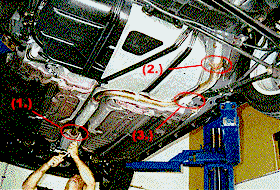 at MAXSPEED
Motorsports. I went to have it installed immediately. Once the
car was on the lift, the first order of business was to begin
removing the piping at the cat. This picture shows John, doing
just this. For an enlarged photo, click
here.
at MAXSPEED
Motorsports. I went to have it installed immediately. Once the
car was on the lift, the first order of business was to begin
removing the piping at the cat. This picture shows John, doing
just this. For an enlarged photo, click
here.
This is a very simple process and is pretty straight- forward.
In order of removal, there are two nuts at the converter flange (1.), two more where the mid-pipe meets
the S-pipe (2.), and then four
rubber hangers. One on the mid-pipe near the S-pipe connection (3.), two hangers: one on either side of the muffler
towards the rear (4.), and one more
on the S-pipe in front of the muffler (not shown) (5.).
either side of the muffler
towards the rear (4.), and one more
on the S-pipe in front of the muffler (not shown) (5.).
Once that is completed, simply install the GReddy in the reverse order. Unless you have a '96 or newer*, it is a direct bolt and the entire job should take no more than 45 minutes (without a lift). Below is a photo of the GReddy muffler and S-pipe. You can clearly see the rubber hanger in this photo.
*See the Cat-Back Exhaust Systems section for a detailed description of the problem.
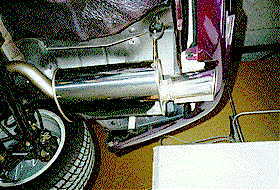 |
As you can see, this is a MUCH better looking exhaust system than the Flowmaster with the Bosal tip. The sound is much more quiet at idle yet loud enough under hard acceleration. I have never experienced any amount of droning, to date. Performance is much improved over the Flowmaster. There is substantially more pull and it starts at a much lower rpm range. |
NOTE: that the entire muffler and tip are polished stainless steel and that the piping from the muffler forward is aluminized steel.
Unfortunately, the install did not go as smoothly as I had
hoped. Since the 1996 and newer models have the OBD-II exhaust
(On-Board Diagnostics), the stock mid-pipe had been lengthened. Due to that, the
GReddy replacement for it was too short by about 6".
Although, I didn't know it at the time, this is a known problem
for aftermarket cat-backs on the '96+ Probes. To work around
this, an extension was welded in place between the resonator and
flange to the converter (see photo). With that, everything was
fine.
mid-pipe had been lengthened. Due to that, the
GReddy replacement for it was too short by about 6".
Although, I didn't know it at the time, this is a known problem
for aftermarket cat-backs on the '96+ Probes. To work around
this, an extension was welded in place between the resonator and
flange to the converter (see photo). With that, everything was
fine.
So what are the main differences between the stock system and the GReddy? Well, by my own measurement, the GReddy piping is about 62mm (~2-7/16") OD, while the factory is 53mm (~2-1/8") OD in the same locale. GReddy shows 60mm piping on the spec sheet for this system, so I assume that they round the 62mm down. Of course, I can't forget that huge 130mm (~5") tip! If you look closely at the photo, you cansee the difference in the pipe diameters.
 Then there is the QUALITY design and
manufacturing of the system. The GReddy is top notch and unlike
the factory system, there are all mandrel bent curves and
corners. The materials used in construction are aluminized steel
and stainless steel, compared to the Ford's cost-effective mild
steel.
Then there is the QUALITY design and
manufacturing of the system. The GReddy is top notch and unlike
the factory system, there are all mandrel bent curves and
corners. The materials used in construction are aluminized steel
and stainless steel, compared to the Ford's cost-effective mild
steel.
There really is no comparison between to the two. The factory exhaust keeps in line with the idea that manufacturers only spent the LEAST amount of time and money on the exhaust that is necessary to make it quiet and pass emissions.
I know that you are now wondering what it looks like on the car. I am going to put some photos up here, but please don't slobber on monitor or drool on your keyboard!
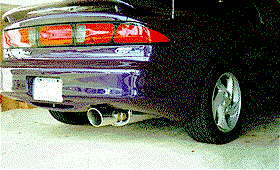
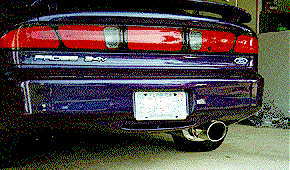
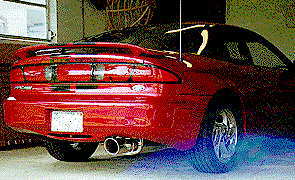

This is one great looking exhaust kit and it gives the sound and horsepower to back up its aggressive style. For anyone who is considering purchasing a cat-back back exhaust system, I HIGHLY recommend the GReddy. It is a little more expensive than the others that are available, but I absolutely believe that it is worth it!
What does it sound like? Here is one .wav of mine (158k) and here is another (197k).
If you have any questions about this install or the kit, feel free to e-mail me.
![]()
![]()
This site made possible by Geocities.